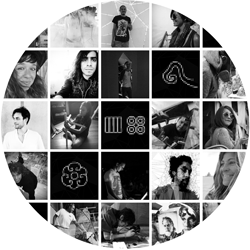
Colectivo Xochipeople / México-Rusia
Xochipeople
Escultura de Luz
Museo Regional de Antropología de Yucatán, Palacio Cantón
Paseo de Montejo 485, Centro
La estatua es de una sola figura sentada sobre una base parecida a un templo. La figura misma, sentada sobre la base, con la cabeza inclinada hacia arriba, ojos abiertos, mandíbula tensa y boca entreabierta y sus brazos abiertos hacia el cielo. Tanto la estatua como la base en la cual se sienta, están cubiertos con detalles calados de organismos sagrados psicoactivos, incluyendo hongos, tabaco, Ololiúqui, Sinicuichi, posiblemente Cacahuaxochitl y una flor no identificada.
De esta manera, Xochipilli representa sin duda, no solamente al príncipe de las flores, pero más específicamente al Príncipe de las flores embriagantes, incluyendo los hongos, que en la poesía Náhuatl eran llamados “flores” y “flores intoxicantes”
El pedestal sobre el cual se sienta está decorado con un diseño representando los cortes transversales de las capas del Psilocybe Aztecorum, un hongo alucinógeno conocido solamente en este volcán.
Xochipilli, entre otros dioses, era representado usando un talismán conocido como “Oyohualli”, el cual era un pendiente con forma de gota elaborado de concha nácar.
The statue is one only figure sitting over a base similar to a temple. The figure itself, sitting over the base with her head looking up, open eyes, tense jaw and the mouth ajar, open arms towards the sky. Both the statue and the base where it sits, are covered with fret worked details of psychoactive sacred bodies, including mushrooms, tobacco, Ololiuqui, Sinicuichi, possibly Cacahuaxochitl and an unidentified flower.
Xochipilli by Xochipeople is a polygonal statue, parametric, medium scale of the Aztec god of arts that proposes a contemporary reliving of our old cultural heritage through a piece of interactive art lit by responsive LEDs derived from the exploring in 3D (3D scan) of the real sculpture of XVI century that can be seen in the National Anthropology Museum in Mexico City.
This way, Xochipilli no doubt represents not only the prince of flowers, but more specifically, the prince of intoxicating flowers, including mushrooms which in the Náhuatl poetry were called “flowers” and “intoxicating flowers”
The pedestal where it is sitting is decorated with a design representing the cross cuts of the capes of the Psilocybe Aztecorum, a hallucinogenous mushroom only known in this volcano.
Xochipilli, among other gods, was represented using a talisman known as “Oyohualli”, which was an earring in the shape of a drop made out of mother of pearl (concha nácar).
Xochipilli beeta’an tumen Xochipeople jump’éel chíikulal ya'ab u tséelil, yéetel u p'iisil, chúumuk nojochil ti’ u yuum k’ujil Azteca its’atil, máax ku kaxantik u ka’a kuxkíinsik te’e k’iino’oba’, úuchben its’at ch’i’ibal yéetel jump’éel its’at nu’ukul sáasilkunsa’an yéetel LEDs responsivo, jok’a’an ti’ xak’al meyaj yáax beeta’an yéetel 3D (3D scan) ti’ u jach jaajil Xochipilli ti’ u sigloil XVI p’aatal tu kúuchil Museo Nacional de Antropología de México.

Xochipeople es un colectivo internacional de creativos, artistas, constructores y makers con base en CDMX que tienen la finalidad de crear instalaciones de arte público, interactivo e inmersivo, promoviendo los valores de la herencia cultural antigua Mexicana a través de la creencia radical que el arte enfocado en la comunidad, inclusión y arte interactivo es vital para la cultura, sólo a través del arte podemos alcanzar un cambio de paradigma en nuestra sociedad.
Xochipeople in an international collective of creatives, artists, builders and makers based in Mexico City with the goal of creating public art installations, interactive and immersive, promoting values of old cultural Mexican heritage through the radical belief that art is focused on the community, inclusion and interactive art is basic for culture, it is only through art that we can get a paradigm change in our society.
Xochipeople junmúuch’ máako’ob tu’ux táaka’an xan táanxelil aj patjo’olajo’ob, aj its’ato’ob, aj beet meyajo’ob yéetel makers ku múuch’ulo’ob CDMX ti’al u beetiko’ob its’at chíikul ti’al cha’antbil, ti’al u béeytal u báaxta’al yéetel u yoksa'aj óolta'al, ikil u kaxanta’al u péektsilta’al úuchben miatsil tu noj lu’umil México tumen ku tukulta’al its’at ku beeta’al ti’al kaaj, ti’al u táakbesa’al máak yéetel ti’al u báaxta’ale’, jump’éel ba’al k’a’anan ti’al miatsil, chéen yéetel its’at ken béeyak u k’expajal jela’an tuukul jets’a’an tumen kajnáalo’ob.
